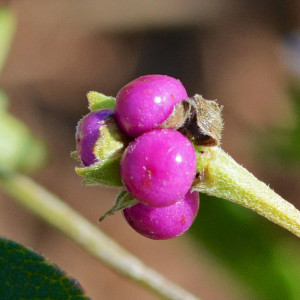This spring I decided to revamp my yard a little bit, removing some poorly performing plants (firebush, believe it or not) and replacing them with species that might be more suited to the growing conditions here. And in my front yard, that means hot and sunny.
Lantana involucrata, commonly known by its taxonomic name but also called button sage or wild sage, fills the bill perfectly. Variously described as occurring naturally “in pinewoods and other dry areas” (Haehle & Brookwell) or “dunes, coastal hammocks, and edges of thickets and coastal scrubs” (Nelson), this plant is reputed to be very attractive to butterflies. I’d tried to grow one earlier in the back yard, but I planted it too close to a baby Wild Lime which quickly overshadowed everything else in that corner of the yard, and the lantana lasted less than a year. Now I’ve got two new ones out front, bracketing the Gumbo Limbo tree that my landscaping consultant urges me to be patient with (years, it’s been here, and barely growing or moving, but she has faith).
She also tells me to give the tree some extra water, which should help the new neighbors (the lantana twins), as according to IRC, their soil requirements are “moist, well-drained limestone or sandy soils, with or without humusy top layer.” Well, I’ve got well drained, I’ve got limestone AND sand, and with the mulch, there’s a bit of a humusy top layer. So as long as I water it in, it should be fine. I should even be able to return to my lazy nonwatering ways after it’s well underway: according to the same source, its drought tolerance is “high; does not require supplemental water once established.”
Another thing I had to keep in mind was that last fall I had the place certified by the North American Butterfly Association as a butterfly garden. That means that I wanted to make sure any new plants were at least as welcoming to the butterflies as the ones I had to take out. And I think I’m doing an OK job: I’m up to 37 species of nectar sources or larval host plant on the property. Of the 18 plants on NABA’s Palm Beach County recommended plant list, I have 10: the three most highly recommended (Cordia globosa, Hamelia patens, and now the third, Lantana involucrata), the two next most highly recommended (Stachytarpheta jamaicensis and Psychotria nervosa), and five others that are farther down the list but are not native to Florida (some of the more highly recommended ones are exotic species that I prefer not to have in the yard).
The lantanas should grow to 3 or 4 feet tall (if I keep them pruned), with white or yellow flowers borne in clusters. The flowers are supposed to be very attractive to butterflies.

The fruit is a small blue berry that should attract plenty of mockingbirds, cardinals, and catbirds:

Etymology
According to Austin, the genus name, Lantana, is from the Latin lenta, flexible. Not sure why a plant genus would be called “flexible,” but whatever…
Whatever its etymology, its use in the landscape is what matters to me. And that is as a butterfly plant that flowers year-round in a dry environment. My kind of plant! Again according to the IRC, we have nearly all the butterflies for which it’s been recorded as a nectar plant (I’ve seen several Horace’s Duskywings, and I hope to see both Florida duskywing and red-banded hairstreak at some point soon). Here’s the list from IRC as of March 2015:
| Common Name | Scientific Name | Plant Uses |
| Cassius Blue | Leptotes cassius | Nectar source. |
| Florida Duskywing | Ephyriades brunneus | Nectar source. |
| Florida White | Appias drusilla | Nectar host[?]. |
| Giant Swallowtail | Papilio cresphontes | Nectar source. |
| Great Southern White | Ascia monuste | Nectar source. |
| Gulf Fritillary | Agraulis vanillae | Nectar source. |
| Julia Heliconian | Dryas iulia | Nectar source. |
| Red-banded Hairstreak | Calycopis cecrops | Nectar source. |
References
Austin, D. 2006. Florida Ethnobotany. Boca Raton, FL: CRC Press.
Haehle, R. G. and Brookwell, J. 2004. Native Florida Plants: Low-Maintenance Landscaping and Gardening. Lanham, Md.: Taylor Trade.
Nelson, G. 2003. Florida’s Best Native Landscape Plants: 200 Readily Available Species for Homeowners and Professionals. Gainesville: U of Florida P.
